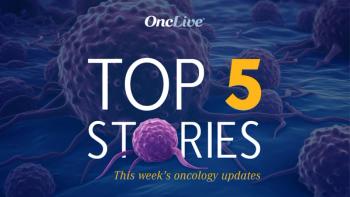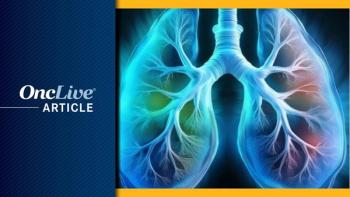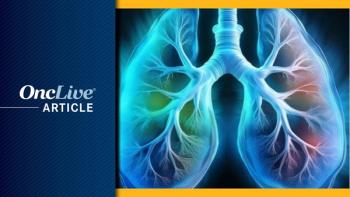
Ensartinib Significantly Prolongs PFS Over Crizotinib in ALK+ NSCLC
Ensartinib showed a significant improvement in progression-free survival over crizotinib with a favorable safety profile in patients with ALK-positive non–small cell lung cancer.
Ensartinib showed a significant improvement in progression-free survival (PFS) over crizotinib (Xalkori) with a favorable safety profile in patients with ALK-positive non–small cell lung cancer (NSCLC), according to results from the phase 3 eXalt3 trial (NCT02767804) that were presented during the 2020 International Association for the Study of Lung Cancer’s World Conference on Lung Cancer Virtual Presidential Symposium.1
Results showed that treatment with the novel second-generation ALK TKI resulted in a median PFS via blinded independent review committee (BIRC) of 25.8 months (95% CI, 21.8–not reached [NR]) versus 12.7 months (95% CI, 9.2-6.6) in the intent-to-treat (ITT) population (hazard ratio [HR], 0.51; 95% CI, 0.35-0.72; P = .0001).
Furthermore, the BIRC-assessed median PFS had not yet been reached with ensartinib (95% CI, 20.2-NR) versus 12.7 months with crizotinib (95% CI, 8.9-16.6) in the modified ITT (mITT) population (HR, 0.45; 95% CI, 0.30-0.66; P <.0001). At 24 months, the median PFS rates were 54% with ensartinib versus 36% with crizotinib; at 36 months, the rates were 51% versus 19%, respectively.
“Ensartinib achieved a 25.8-month median PFS in the ITT population and the median PFS has not been reached in the mITT population as assessed by BIRC in this preplanned analysis,” Leora Horn, MD, MSc associate professor of medicine in the Division of Hematology/Oncology at Vanderbilt-Ingram Cancer Center, said in a presentation during the meeting. “With longer follow-up, ensartinib is trending toward further improved median PFS in patients without brain metastases at baseline.”
ALK aberrations are identified in approximately 5% to 7% of all patients with NSCLC,2 and preclinical data have indicated that the once-daily oral ALK inhibitor ensartinib has proven to have broad activity against ALK resistance mutations.3 In fact, the agent has been found to have potency that is ten-fold that of crizotinib in enzymatic assays.3
Additionally, ensartinib has demonstrated encouraging antitumor activity in patients with ALK TKI–naïve, crizotinib refractory, advanced ALK-positive disease, including those with brain metastases, according to Horn.4-6
In the global, open-label, multicenter, phase 3 eXalt3 trial, investigators set out to examine the efficacy and safety of ensartinib versus crizotinib in patients with ALK-positive NSCLC. To be eligible for enrollment, patients had to have stage IIIB/IV NSCLC, have ALK positivity via local FDA-approved assays or central confirmation via FISH by Abbott, and an ECOG performance score of 0 to 2. Participants also had to have not received any previous treatment with an ALK inhibitor and they had to have 1 or less prior chemotherapy regimens.
Patients were stratified by prior chemotherapy, ECOG performance status, region of the world, and the presence of brain metastases at baseline. They were then randomized 1:1 to receive either 225 mg of ensartinib once daily or 250 mg of crizotinib twice daily. No crossover was permitted. As of November 2018, the trial was fully accrued, noted Horn.
The primary end point of the trial was BIRC-assessed median PFS per RECIST v1.1 criteria in the ITT population, while key secondary end points included overall survival (OS), objective response rate (ORR), duration of response (DOR) both overall and in the brain specifically, and time-to-treatment failure (TTF) in the brain.
One interim analysis was planned for when approximately 75% of median PFS events per BIRC were reported in the ITT population (n = 143/190 events). The median PFS was tested at a 2-sided alpha level of 0.019.
In accordance with the protocol, a total of 3 prespecified randomized patient populations were included in the analysis: the ITT population, who had locally determined ALK-positive NSCLC; the mITT population, who had centrally confirmed ALK positivity per FISH test; and the safety population, who received more than 1 dose of either study drug.
As of the data cutoff of July 1, 2020, 45% of patients receiving ensartinib were still receiving treatment versus 17% of patients receiving crizotinib. A total of 139 BIRC-assessed median PFS events were reported in the ITT population, while 119 BIRC-assessed mPFS events were reported in the mITT population.
A total of 396 patients were screened and 290 of those patients underwent randomization. Of those randomized, 143 patients were randomized to receive ensartinib, while 147 patients were enrolled to the crizotinib arm; this made up the ITT population. Of these patients, 43 were found to not be centrally confirmed to be ALK positive; thus, the mITT population included a total of 247 patients. Of those 247, patients, 121 were randomized to receive ensartinib and 126 would receive crizotinib.
The median age of participants was approximately 54 years, and about half of them were male. Additionally, more than half of the patients included on the trial were Asian and the majority had an ECOG performance status of 0 or 1 and were never-smokers, according to Horn.
Notably, 33% of patients on the ensartinib arm had brain metastases at baseline versus 39% of those on the crizotinib arm. Moreover, 5% of patients on both treatment arms had previously received radiation therapy. Twenty-four percent of patients on the ensartinib arm had received prior chemotherapy versus 29% of those on the crizotinib arm.
Additional results from the trial showed that the BIRC-assessed confirmed systemic ORR for patients who received ensartinib (n = 121) was 75% versus 67% for those who received crizotinib (n = 126). Moreover, the complete response rates for ensartinib versus crizotinib were 14% and 6%, respectively.
The BIRC-assessed median DOR had not yet been reached with ensartinib (n = 91; 95% CI, 22.05-NR) versus 27.3 months with crizotinib (n = 85; 95% CI, 11.27-NR). At 24 months the median DOR rate was 58.7% with ensartinib (95% CI, 45.24-69.90) versus 50.0 months with crizotinib (95% CI, 37.80-61.09); at 36 months, these rates were 58.7% (95% CI, 45.24-69.90) and 26.7% (95% CI, 6.75-52.34), respectively.
In the participants in the mITT population who had measurable brain metastases at baseline, the BIRC-assessed intracranial confirmed ORR with ensartinib (n = 11) was superior to that of crizotinib (n = 19), at 64% versus just 21%, respectively.
The BIRC-assessed TTF rates at 12 months with ensartinib (n = 81) versus crizotinib (n = 76) in patients in the mITT population who did not havebrain metastases was 4.2% (95% CI, 1.4-12.8) and 23.9% (95% CI, 15.8-36.2), respectively (HR, 0.32; 95% CI, 0.15-0.64; P = .0011).
The median PFS in patients without brain metastases at baseline had not yet been reached with ensartinib (95% CI, 25.8-NR) versus 16.6 months with crizotinib (95% CI, 12.7-29.5), with a HR of 0.40 (95% CI, 0.23-0.70; P = .0009).
Additionally, the median OS had not yet been reached in either treatment arm in the mITT population (HR, 0.88; 95% CI, 0.52-1.50; P = .6470), with only 20% of events having occurred in both arms, according to Horn.
With regard to safety, serious treatment-related adverse effects (TRAEs) were reported in 8% of participants who received ensartinib versus 6% of those who were given crizotinib. “The most common TRAEs for patients on ensartinib were skin toxicities, including rash and pruritis, as well as elevations in liver function tests (LFTs),” said Horn. “The majority of these were grade 1 or 2.”
Moreover, treatment-related toxicities that led to dose reductions were reported in 24% of those on the crizotinib arm versus 20% of those on the crizotinib arm. TRAEs led to treatment discontinuation in 9% and 7% of those on the ensartinib and crizotinib arms, respectively.
“Ensartinib showed superior efficacy in the brain over crizotinib in patients with known brain metastases at baseline,” concluded Horn. “Ensartinib showed a favorable safety profile with low-grade rash and transaminitis being the most frequently reported TRAEs, and it represents a new first-line treatment option for patients with ALK-positive NSCLC.”
References
- Horn L, Wang Z, Poddubskaya E, et al. Phase 3 randomized study of ensartinib vs crizotinib in anaplastic lymphoma kinase (ALK)–positive NSCLC patients: eXalt3. Presented at: International Association for the Study of Lung Cancer 2020 Presidential Symposium; August 8, 2020; Virtual. Abstract 2.
- Tsao AS, Scagliotti GV, Bunn PA, et al. Scientific advances in lung cancer 2015. J Thorac Oncol. 2016;11(5):613-638. doi:10.1016/j.jtho.2016.03.012
- Lovly CM, Heuckmann JM, de Stanchina E, et al. Insights into ALK-driven cancers revealed through development of novel ALK tyrosine kinase inhibitors. Cancer Res. 2011;71(14):4920-4931. doi:10.1158/0008-5472.CAN-10-3879
- Horn L. Infante JR, Reckamp KL, et al. Ensartinib (X-396) in ALK-positive non–small cell lung cancer: results from a first-in-human phase I/II, multicenter study. Clin Cancer Res. 2018;24(12):2771-2779. doi:10.1158/1078-0432.CCR-17-2398
- Fang W, Ma Y, Huang J, et al. Ensartinib (X-396), a second-generation ALK TKI, in Chinese ALK-positive non-small cell lung cancer: a phase I, dose-escalation study. J Clin Oncol. 2018;36(suppl 15):e21122. doi:10.1200/JCO.2018.36.15_suppl.e21122
- Yang Y, Zhou J, Zhou J, et al. Efficacy, safety, and biomarker analysis of ensartinib in crizotinib-resistant, ALK-positive, non-small-cell lung cancer: a multicentre, phase 2 trial. Lancet Respir Med. 2020;8(1):45-53. doi:10.1016/S2213-2600(19)30252-8

























































































